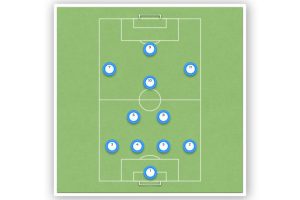Why the Target Man Position is Fading in Modern Soccer
As a soccer enthusiast, I have noticed a significant decline in the use of the target man position in modern soccer. The target man, also known as the center forward, is a player who is typically tall, strong, and has a great aerial presence. The target man’s primary role is to hold up the ball and bring other players into the game by flicking the ball on or laying it off to teammates.
However, in recent years, the target man position has become less common in modern soccer. This shift can be attributed to several factors, including changes in tactics and formations, the rise of possession-based play, and the increasing emphasis on speed and mobility in modern soccer. These factors have made it more challenging for target men to have a significant impact on the game.
In this article, I will explore why the target man position is becoming less common in modern soccer. I will examine the reasons behind this trend and discuss the implications for the game. By the end of this article, you will have a better understanding of the changing nature of soccer and the role of the target man in modern soccer.
The Evolution of Soccer Tactics
As soccer has evolved over the years, so have the tactics used by teams. The target man position, once a staple of many teams, has become less common in modern soccer. This is due in part to the emergence of new tactics that prioritize ball possession and movement over a more direct approach.
The Emergence of Tiki-Taka
One of the most influential tactical innovations in modern soccer has been the emergence of Tiki-Taka. This style of play, made famous by FC Barcelona and the Spanish national team, emphasizes short passes and quick movement to maintain possession and control the tempo of the game. Tiki-Taka requires players who are technically proficient and comfortable on the ball, making the role of the target man less important.
Instead of relying on a big, physical striker to hold up play and win aerial duels, Tiki-Taka focuses on creating passing triangles and overloading areas of the field to create space and opportunities for attacking players. This style of play requires a high level of coordination and teamwork, but when executed correctly, it can be incredibly effective.
The Rise of the False 9
Another factor contributing to the decline of the target man position is the rise of the False 9. This is a tactical approach that involves playing without a traditional center forward, instead using a more mobile attacking player who can drop deep and link up with midfielders.
The False 9 requires players who are comfortable operating in tight spaces and can create chances through their movement and dribbling ability. This approach can be difficult to defend against, as it can create confusion among opposing defenders and force them to adjust their shape and positioning.
Overall, the evolution of soccer tactics has led to a decreased emphasis on the target man position. While there are still teams that employ this approach, it is becoming less common at the highest levels of the sport. As teams continue to experiment with new tactics and styles of play, it will be interesting to see how the role of the target man evolves in the future.
The Decline of the Target Man
As a soccer coach and fan, I have noticed a significant decline in the use of the target man position in modern soccer. In this section, I will explore the reasons behind this trend.
The Changing Role of Strikers
The target man position is typically played by the striker, whose main role is to score goals. However, the role of the striker has evolved in modern soccer. Strikers are now expected to contribute more to the team’s overall play, such as dropping deep to receive the ball and creating chances for their teammates. This means that the traditional target man, who is usually a tall and physically imposing player, may not have the necessary skills to fit into this new role.
Furthermore, many teams now prefer to play with a lone striker, rather than two up front, which means that the striker needs to be more mobile and versatile. A target man who is limited to playing in a fixed position in the penalty area may not be the best fit for this system.
The Importance of Versatility
Another reason for the decline of the target man position is the increasing importance of versatility in modern soccer. Coaches now prefer players who can play in multiple positions and adapt to different systems and styles of play. This means that a player who can only play as a target man may be seen as less valuable than a player who can play as a striker, winger, or attacking midfielder.
Moreover, the trend towards possession-based soccer means that teams now place a greater emphasis on technical ability and passing accuracy. A player who is primarily valued for their aerial prowess may not be as effective in this style of play. Teams now prefer players who can contribute to the team’s possession game and help create chances through intricate passing and movement.
The Future of Soccer Tactics
The Rise of the False 10
As soccer evolves, so do the tactics used on the field. One trend that has emerged in recent years is the rise of the false 10. This position is a hybrid between a traditional number 10 and a false 9, with the player dropping deep to create space and opportunities for their teammates. The false 10 is often used in possession-based systems, where the team looks to dominate the ball and control the tempo of the game. This position requires a player who is comfortable on the ball, has excellent vision, and can play incisive passes to unlock defenses.
The Importance of Fluidity
Another trend that is becoming increasingly important in modern soccer is fluidity. Gone are the days of rigid formations and fixed positions. Instead, teams are looking to create dynamic systems that allow players to interchange positions and roles seamlessly. This requires a high level of tactical understanding and communication between players, as well as technical ability and versatility. Fluid systems can be difficult to defend against, as they create uncertainty and confusion for opposing teams. Overall, the future of soccer tactics is likely to be characterized by innovation and experimentation. Coaches will continue to search for new ways to gain an edge over their opponents, and players will need to be adaptable and open-minded to succeed in the ever-changing landscape of modern soccer.
Final Thoughts
As I wrap up this article, it’s clear that the target man position has been losing its place in modern soccer. While this position was once a crucial part of many teams’ attacking strategies, the evolution of the sport has made it less necessary.
One reason for this is the increasing importance of quick, agile players who can move the ball up the field with speed and precision. This has led to a greater emphasis on possession-based play, with teams looking to control the ball and create scoring opportunities through quick passes and movement.
Another factor is the rise of the false nine position, which has become increasingly popular in recent years. This position involves a player dropping back into midfield to receive the ball and create space for other attackers to make runs. This means that the false nine can act as a target man when needed, but also has the versatility to drop back and create opportunities for other players.
Overall, while the target man position may still have a place in certain teams and situations, it’s clear that it is becoming less common in modern soccer. As the sport continues to evolve, it will be interesting to see how attacking strategies continue to change and adapt to new trends and styles of play.






